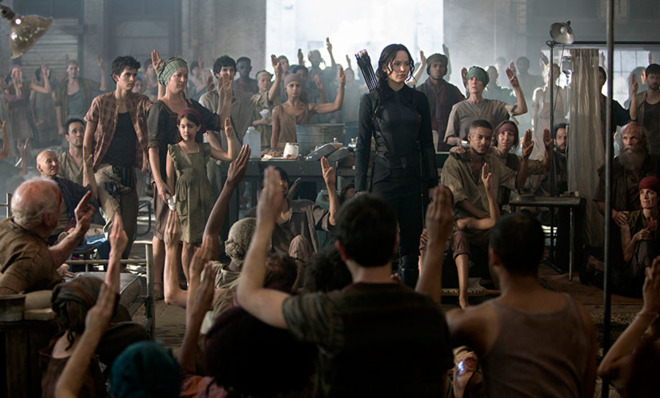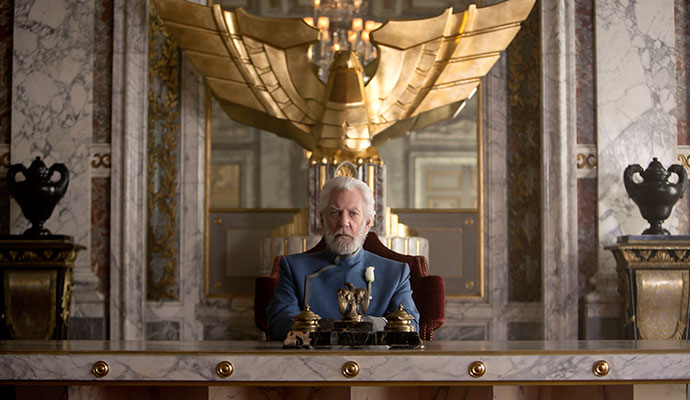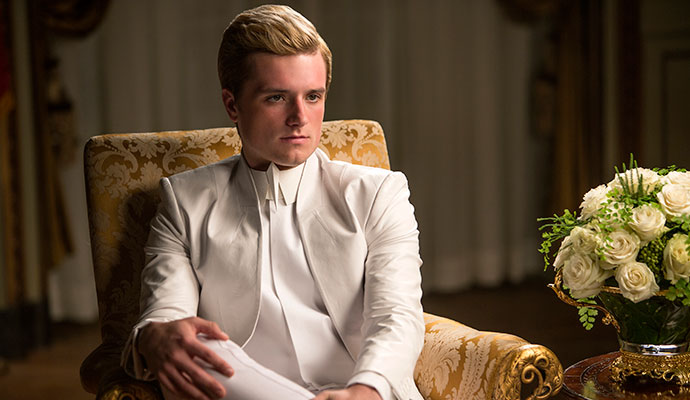The Hunger Games: Mockingjay — Part 1: 10 major differences between the book and the movie
Wondering what was lost (or added) to the latest Hunger Games movie on its way to the big screen? Read our comprehensive guide.

The Hunger Games: Mockingjay — Part 1 arrives in theaters today. It is adapted from the first half of Suzanne Collins' Mockingjay, the final volume in the Hunger Games trilogy. (Part 2, which will conclude the film series, will arrive in 2015.)
Splitting Mockingjay into two parts gave screenwriters Peter Craig and Danny Strong more room to tell the story — but that doesn't mean that changes haven't been made to the source material. Here are 10 major differences between the book and the movie:
1. Katniss' visit to the decimated District 12 is delayed
The Week
Escape your echo chamber. Get the facts behind the news, plus analysis from multiple perspectives.

Sign up for The Week's Free Newsletters
From our morning news briefing to a weekly Good News Newsletter, get the best of The Week delivered directly to your inbox.
From our morning news briefing to a weekly Good News Newsletter, get the best of The Week delivered directly to your inbox.
The book opens as Katniss visits the ruins of District 12, which was destroyed at the end of the previous book, Catching Fire. The film, on the other hand, opens in District 13, during an encounter between Katniss, Plutarch Heavensbee, and President Coin. Plutarch pushes Coin to send Katniss back to District 12, and she finally relents.
Why it's important: In the film, the first major encounter between Katniss and Coin disappoints Coin. Coin expects Katniss to be a fierce heroine who will lead the rebels into battle. Instead, she finds a bitter young woman complaining about the rebels' plans. The film scene establishes Coin's initial impression of Katniss, setting the stage for her to eventually change her mind.
2. Snow's subtle use of language
Because the book is told from Katniss' perspective, the audience only sees what she does. In an early scene that's exclusive to the film, President Snow works with an assistant to develop the proper language to use when talking about the "rebels." He decides to call them "radicals" in his public announcements, painting them as extremists whose viewpoints are unworthy of consideration.
A free daily email with the biggest news stories of the day – and the best features from TheWeek.com
Why it's important: The scene helps to explain the strategy by which President Snow retains control over the populace. By calling the rebels "radicals," Snow undermines their credibility and their power.
3. Citizens are murdered by the government
Snow is also a big believer in using fear to quell the growth of the rebellion. In the film, he gives a public address noting that the use of the "mockingjay" — a symbol of the rebellion — is strictly forbidden. During his address, he orders Peacemakers in all of the 11 main districts to execute those who break the law. The movie shows these executions taking place, while the book never mentions this scene.
Why it's important: Language is not the only tool at President Snow's disposal. He also has force, and he's willing to use it — another key insight into the way he maintains power.

4. Peeta's outburst is removed
In the book, Peeta becomes upset when Caesar suggests that both he and Katniss were involved in the rebellion at the end of the Quarter Quell: "On his feet, leaning into Caesar's face, hands locked on the arms of his interviewer's chair." In the movie, this encounter is toned down, with no fiery outburst.
Why it's important: The book depicts Peeta's spirit in a way that's missing from the film, as well as his efforts to protect Katniss from being implicated if she's ever captured.
5. Effie replaces the full prep team
After she decides to become the mockingjay, Katniss' appearance takes on great importance in both the book and the movie. In the book, the prep team from her previous public appearances dresses her up and prepares her make-up. In the movie, that prep team is missing. Instead, Effie Tricket — whose whereabouts are unknown in the first half of the book — takes the team's place.
Why it's important: Effie was a standout character from the first two films, offering a much-needed dose of humor. Her presence adds some light that was missing from the book, which is much darker in tone.
6. The darker side of President Coin is hidden
In the book, President Coin is more of a control freak: over Katniss, her prisoners, and even the schedules of her fellow rebels. The movie slow-plays this more tyrannical side of Coin's personality, keeping her motives in question.
Why it's important: In the book, Coin's early actions foreshadow the psychotic decisions she makes later in the story. The film makes her far less predictable.
7. Peeta isn't beaten
In the film, Katniss assumes Peeta doesn't realize that District 12 has been destroyed by President Snow. During one of his television interviews, Beetee interrupts the Capitol's television signal and shows the destruction of District 12, leading Peeta to warn Katniss and District 13 about the bombs headed their way. After his warning, the Capitol ends the interview and shuts off the feed before Peeta is injured. In the book, after he warns District 13 about the attack, Peeta is seen being beaten on television with his blood splattering on the floor.
Why it's important: The film — in what's likely an attempt to steer away from a harsher MPAA rating — doesn't show the attack on Peeta.

8. The reason for attempting to rescue Peeta has changed
After the attack on District 13, Katniss realizes that President Snow is using Peeta to get to her. Her nervousness about serving as the living embodiment of the mockingjay forces President Coin to plan a rescue of Peeta and the other hostages. In the book, Coin realizes that Katniss would be unwilling to cooperate fully if Peeta wasn't rescued. The movie offers a different reason: preventing President Snow from using Peeta as a pawn to keep the rebels at bay.
Why it's important: In the movie, District 13 saves Peeta for political reasons; in the book, it's for personal ones. In this way (and in several other ways), the film is more focused on the public relations war between the Capitol and the districts, not just the battlefield.
9. The rescue of Peeta is more action-packed
As part of the film's rescue, the rebels are sent to destroy a dam that provides electricity to the Capitol. The rebels in District 13 watch the rescue live on their television screens, and when they start running out of time, Katniss confronts Snow over the television screen. They argue and Katniss offers to give herself up to save Peeta. In the book, the dam explosion is briefly mentioned, but there's no live feed of the rescue, and no confrontation between Katniss and Snow.
Why it's important: The film's rescue is far more acction-packed than the one in the book, adding more drama to round out the "climax" of the film (which is only the midpoint of the story in the book).
10. Snow lets Peeta leave
After Peeta is rescued in the film, Gale tells Katniss how easy the rescue was. He says that the Capitol had a chance to kill them during the attempt and opted not to. In the book, Katniss doesn't realize how easy the rescue was immediately after it occurred.
Why it's important: The film goes out of its way to emphasize that Snow wanted Peeta to be rescued, and was willing to let him go. He knows that Peeta is a tool he can now use against Katniss.

